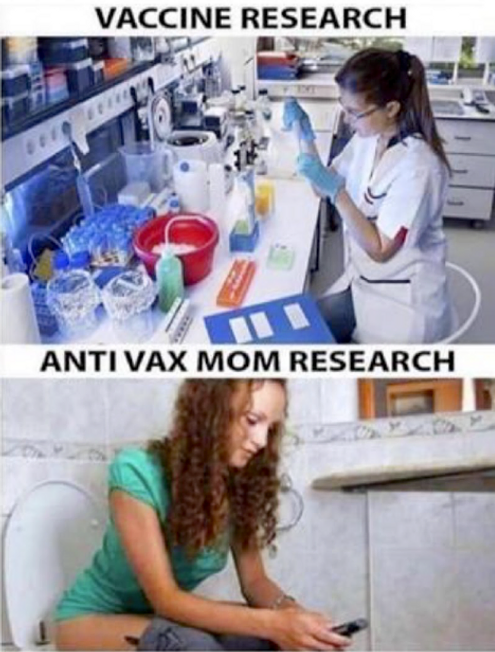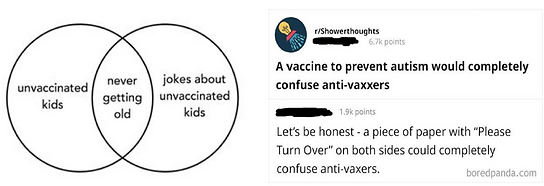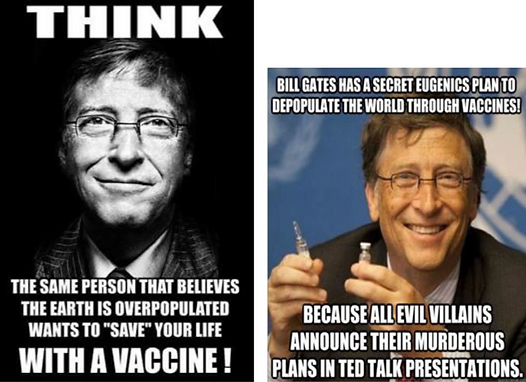Getting The Joke?
Title: Injecting fun? Humour, conspiracy theory and (anti)vaccination discourse in popular media
Author(s) and Year: Anastasiya Fiadotava; Anastasiya Astapova; Rebecca Hendershott; Merryn McKinnon; Anna-Sophie Jürgens
Journal: Public Understanding of Science; 2023, Vol. 32(5) (Closed access)
TL;DR: Vaccination and the pandemic don’t seem very funny, yet this study showed the unexpected ways humor enters into the debate surrounding both and ventures some tentative conclusions about the functions vaccine jokes serve.
Why I chose this paper: Humor has little overt place in science; at the same time humor cannot be denied and asserts itself everywhere. I’m fascinated at the ways humor functions and the reasons people can’t help being funny in the midst of the most serious crises.
The problem
It might have been just another set of Facebook posts in the long social media war between supporters of vaccination and vaccine skeptics. In this one, vaccine supporters competed to make sarcastic derisive comments about people who thought Bill Gates planned to use vaccines to decimate the world population:
No, Mr Bond! I expect you to vaccinate!
i seriously read an argument one time where a woman told people that bill gates had a ray gun that made 3rd world country men strile! and people believed her! it makes me want to strangle people
oh lovely
lol lol
Ya know what really ticks me off? I spent the years from 1990 to 2010 hating Bill Gates as an unethical pirate, and guess what? I was wrong. The SOB HAS ethics and DOES care. Who am I gonna throw stones at now?
What set this one apart was the object of the commenters’ derision: a grinning photoshopped image of Gates holding a bottle of serum and syringe with a glaring headline as depicted in Fig 1 : BILL GATES HAS A SECRET EUGENICS PLAN TO DEPOPULATE THE WORLD THROUGH VACCINES! BECAUSE ALL EVIL VILLAINS ANNOUNCE THEIR MURDEROUS PLANS IN TED TALK PRESENTATIONS.

Conspiracy theories, which always surrounded the long debate over vaccine safety and vaccine hesitancy, ramped up during the COVID-19 pandemic, creating new opportunities for emotions to play a role in the debates. Strong emotions aren’t always easy to contain, of course. When they erupt into verbal and visual humor, it can give the vaccine debate an unexpected shot in the arm (apologies for the dad joke) while throwing new light on the full range of feelings and understandings people hold about vaccines. What kinds of feelings and understandings? Anastasiya Fiadotava and her colleagues wanted to find out.
It’s long been known that social media can amplify health messages, but the ease of sharing information over the internet also risks losing control as others offer their own comments. With no filter, social media memes can easily conflate information and misinformation or create echo chambers reinforcing similar viewpoints. All of this can help build community while also contributing to the anti vaccination movement.
Humor adds another element to the mix. Does it convince believers to change their ways or simply spread misinformation more efficiently? Does it create a sense of solidarity among those who get the joke? When vaccine skepticsmake jokes online, their humor may influence peoples’ thinking by mocking established attitudes toward vaccination. Internet humor shapes and reflects attitudes, making these questions more relevant as the internet has contributed to the spread of all kinds of humor.
Method
Fiadotava and colleagues wanted to understand the relationship between serious and humorous aspects of the vaccination debate (before and during the pandemic) and the internal functioning of humor vaccination. They searched online for images with the keywords ‘vaccination’, ‘anti-vaccination’, ‘humor’, ‘jokes’, ‘funny’, and ‘memes,’ then searched social media platforms that included both posts and comments including Facebook, Pinterest, Twitter, the internet meme site 4chan and websites about pop culture such as Know Your meme and Bored Panda using the same keywords. Pro and anti-vaccination Facebook groups were also searched. This search produced 320 humorous posts which they analysed, looking for –
• key thematic categories; e.g. life expectancy, effectiveness and ingredients
• format such as image only, text only or both
• attitude towards vaccination: positive, negative, mixed or unexpressed
• logical mechanisms of humor such as analogy, exaggeration, juxtaposition
Findings
The most frequent logical mechanisms employed were analogy, exaggeration and juxtaposition. Analogies and exaggerations let both the pro and anti vaccine groups simplify complex arguments and move them into familiar frames of reference. Exaggeration was used to underscore the stupidity of opponents as depicted in Fig 2.

Vaccine advocates juxtaposed the science behind vaccine research with their portrayals of vaccine opponents’ meager efforts to find facts, implying that they were ill-informed (Fig 3)

Unsurprisingly perhaps, a lot of the humor was for or against vaccination. Anti vaccine humor frequently ridiculed either the ineffectiveness and risk of the vaccines themselves or those who support mandatory vaccination. (Figs 4a & b)

Many vaccine supporters joked that the main side effect of vaccines is being able to grow up and become an adult.
Both sides joked about science but in different ways. Pro-vaccine humor ridiculed opponents’ ignorance of science. Anti-vaccine humor pointed to the drawbacks of science. (Fig 5)

Both groups managed to use Bill Gates’ vaccination advocacy for their own purposes. (Fig. 6)

The Impact
The authors see humor as intrinsically social in nature. Humor and seriousness were inseparably intertwined but the two sides favored different themes: science and life expectancy for the vaccine supporters, safety and conspiracies for the antis. Both sides used the shared emotional response of humor to increase a feeling of group solidarity. That meant humor often worked as a mechanism of exclusion, branding the out-group as stupid and the in-group as superior.
Both sides focused on topics that worked to their advantage and neglected topics that might challenge their confirmation bias. Most comments came from like-minded individuals, leading the authors to wonder how persuasive the humor was or whether it preached mainly to the converted.
The authors believe this humor is further evidence that the media never simply conveys neutral scientific information. Moreover, the presumed division in science discourse between “serious” and “funny”is a false dichotomy. Crude or subtle, the humor showed how specific groups interpreted scientific information and found their own meanings within it, contributing to a dialogue about knowledge and its role in public discourse.
Edited by Mahima Samraik and Niveen AbiGhannam
Cover image credit: Creative Commons

